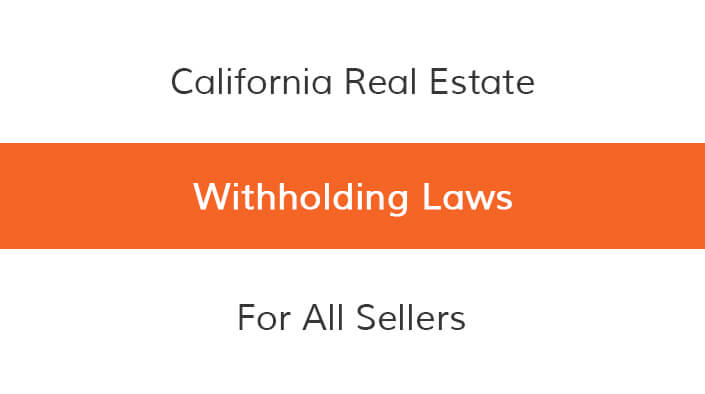Updated January, 2020 to reflect new Franchise Tax Board form
(State of California Real Estate Withholding
under the Revenue and Taxation Code Section 18662)

Are you an individual who is looking to sell a property in California?
There are no restrictions for you to buy, but when it comes time to sell, you will need to plan in advance because the State of California has some laws that may apply to you, whether you are a foreigner, an individual living out-of-state, or an individual investor.
Knowing about the laws and planning in advance will save you much time, effort and headaches when the time comes.
This article is written as an educational tool for other Escrow Officers (Settlement Agents) and for Real Estate Agents, but as an Investor, it is definitely to your advantage to see what you need to know when you are going to sell that property located in California.
The State regulations regarding withholdings on real property sales is a little different from the Federal withholding of foreigners under the FIRPTA guidelines.
For the State, the law is written such that all real property being sold requires the payment of tax at the close of escrow in an amount equal to 3.33% of the Sales Price. An Alternative Calculated Amount can also be used.
The amount is withheld by the Settlement Agent from the Seller’s account at the closing of the transaction and sent to the Franchise Tax Board (FTB).
The amount is considered a “prepayment” of income taxes on the potential gain.
The withholding applies to all Sellers, whether they are U.S. citizens, permanent residents with green card, foreigners, individuals who live out-of-state, or individuals who live in the State.
This article is presented to delineate the certain exemptions that can be used to bypass the regulation.
The law did not change, but the forms changed in 2020, combining the original 4 different forms (593C, 593E, 593I, 593) into one 593 Real Estate Withholding Statement. A copy of the 2020 version of this form can be accessed at this link: https://www.ftb.ca.gov/forms/2020/2020-593.pdf . Be sure you choose the version for the current year.
This article is presented to address the important parts of the law and delineate the certain exemptions that can be used to satisfy the regulation.
1. Withholding amount:
The standard Withholding Amount is 3.33% of the Sale Price.
An Alternative Withholding Amount can be computed by completing Part VI (Computation) and then checking the proper box under item #29 and #30.
Settlement Agents: Do not round off decimal points. Calculate based on 3.33% or the Alternative Calculation and keep the decimal points. You can send in an amount that is more than the standard Withholding or Alternative Amount, but you must not send in less or it will be rejected.
Sellers: You may request that the Settlement Agent send in a Withholding Amount for you, even though it is not required by regulation. This amount will be considered a “prepayment” of your income tax return to be filed for the year.
2. Exemptions:
The full list of exemptions can be found on Part III and Part IV of 593 form. Here are the most common ones that the Seller should be made aware of:
- If the sales price is $100,000.00 or less, the exemption is automatic, no form needs to be completed
- The Seller has owned and used the property as his principal residence at least 2 out of the 5 year period right before the sale
- The Seller is a California corporation, limited liability company or partnership that is NOT a single member entity (the ownership is one sole individual) and which is registered to do business in California
- The Seller can claim a loss or zero gain on the sale by filling out Part VI (Computation)
- 1031 Tax Deferred Exchange transactions: If the Seller will be replacing the property, which is declared to be an income property for his tax purposes, by purchasing a new one immediately or soon after, then this can be done under an IRS 1031 tax deferred exchange regulations. In this case he can check one of the boxes on Part IV to claim exemption. However, if he does not conclude the exchange or if only part of the funds are used, then the withholding will still need to be done on the amount not used.
- Installment Sale transactions: When the Seller is lending part of his Sale Price as a loan to the Buyer, the transaction becomes an “installment sale”. This means that the Seller is not getting all his money at the close of escrow, but will get it in installment payments after the closing. This “exemption” is different. The part of funds that the Seller does receive at close of escrow– Sales Price minus the Installment Note amount – will require the withholding. The FTB calls this the “first installment”. Every time the Buyer pays down the principal on this loan, he will have to do the withholding on the principal paid and send that amount to the FTB.
Settlement Agent: Please be sure that the Buyer completes and signs Part V of the 593 (Buyer/Transferee information) at close of escrow.
Please note: If the parties decide NOT to continue with the withholding after close of escrow, the Seller must declare the full Sales Price on his next tax return, pay the balance of the Withholding or Alternative Amount, and then send a written request to the FTB to release the Buyer from withholding on the installment sale payments.
On an installment sale the FTB WILL NOT allow payment of the full Withholding or Alternative Amount at the time of closing, even if both parties want to do so. FTB will reject the payment and ask the Seller and Buyer to withhold and pay per their regulations.
The exemptions, with the exception of the first one, are not automatic.
The Settlement Agent must provide Seller the 593 form to be reviewed, completed and signed. If the Seller can check any one of the boxes on Part III or IV, under penalty of perjury, then the transaction is exempt.
3. Can I submit a lower tax amount?
Please refer to answers in Question 1.
The standard withholding is 3.33% of the Sales Price. Sellers can pay more, but not less unless they take advantage of Part VI and request an Alternative Amount, like 12.3% on the gain amount for an individual or 8.84% or 13.8% for a corporation, depending on the type of corporation.
In order to withhold on this lesser rate the Seller must calculate the amount of gain, select the appropriate box on #29 and complete the amount on #30. Form 593 should be given to the Settlement Agent who will withhold this amount and send it to the State.
Please note: It is absolutely important that the Seller’s accountant is involved in completing the forms and figuring the calculation for withholding. After all, this accountant will be responsible for declaring the income tax at the end of the fiscal tax year for the Seller.
4. Do I need a Tax ID number?
Yes! One of the important aspects of the 593 form is that even if the Seller is able to check one of the boxes on the form, but is not able to provide a Social Security Number or Individual Tax Identification Number (ITIN), then the form itself is void and the full withholding is automatically required.
This means that a foreigner who uses the property as his principal residence MUST have an ITIN number in order to qualify for the exemption.
If the Alternative Amount is used and Seller has applied for the ITIN, Seller can put “Applied For” in the ITIN box under Part II. When the ITIN is received from the IRS then it should be remitted to the FTB so that proper credit can be given to the Seller.
To apply for an ITIN, the foreigner can obtain and submit form W-7 form to the IRS (see instructions).
Recommendation: The foreign Seller should go to an accountant who is well versed in this area to apply for the ITIN immediately or even before a sale of the property is contemplated. It takes 6-8 weeks for an ITIN to be issued.
Settlement Agent: If the ITIN has been applied for but not issued before the transaction closes, withhold on the full 3.33% or Alternative Withholding and mark “Applied for” on Seller’s ITIN box. Once the ITIN comes in, send in an Amended 593 form to the FTB for the Seller.
5. How do I get my money back?
The tax amount must be sent to the state by the Settlement Agent within 20 days from the end of the month in which the transaction closed.
The amount sent to the Franchise Tax Board is a “prepayment” of income tax due on the gain.
This means that to get the money back the Seller must file their income tax return at the end of the fiscal year and include a copy of the 593 Form that the Settlement Agent provides at closing.
If the funds sent to the Franchise Tax Board are more than the tax liability for that year, the FTB will refund the difference.
6. Whose responsibility is it to make sure the law is followed?
Like the Federal FIRPTA laws, the responsibility for the withholding requirement falls on the Buyer. However, the Franchise Tax Board realizes that the Buyer may not know what to do so they put the responsibility on the Settlement Agent to obtain the signatures on the correct withholding forms and send the amounts to the FTB as the “Remitter”.
Settlement Agent: The Franchise Tax Board requires that the Settlement Agent gives proper written notification to the Buyer regarding this withholding regulation, and will require this notification to appear in the Escrow Instructions – “in accordance to Section 18662 of the Revenue and Taxation Code, a Buyer may be required to withhold an amount equal to 3 1/3% of the sales price….” It must also state how the exemptions can apply.
The language can be seen on FTB’s Publication 1016 which you can download from their website at this link: https://www.ftb.ca.gov/forms/misc/1016.html
If the withholding is not done, or not done correctly, then all parties, including the Remitter, may become liable for the tax and penalties.
This is a good reason why Buyers and Sellers must be sure that they are using a Settlement Agent who is knowledgeable and experienced in this law and who knows what needs to be done, what to expect, and what are possible solutions.
7. Whose responsibility is it to complete the forms?
It may be the Settlement Agent who provides the forms and does the withholding, but it is the Seller’s responsibility to complete the forms correctly and seek independent financial and legal counsel.
As the forms state, “title and escrow persons, exchange accommodators are not authorized to provide legal or accounting advice on the withholding amounts”.
8. Must Settlement Agents verify that the certificates are completed correctly?
If the Settlement Agent has actual knowledge that the form is not completed correctly, then the form must be rejected and returned to the Seller.
If Settlement Agent has no knowledge of the facts, then they can only verify that the certificates are completed and signed.
For instance, if Settlement Agent has no knowledge if the property is truly the principal residence, they can only receive in the form as given by the Seller.
However, if the Seller claims it is a partnership, but the title on the property clearly states that it is under individuals, then this is actual knowledge and Settlement Agents cannot accept a 593 that is filled out incorrectly.
Please note: the 593 form is completed under penalties of perjury. Perjury means to willfully make a false statement.
9. What if there are multiple Sellers in one transaction?
If the sales price in the transaction is less than $100,000, the first exemption still applies.
If the sales price in the transaction is more than $100,000, then each Seller would have to complete his own 593 form and show his ownership percentage.
If one of the Sellers does not actually own a percentage but is listed as a Seller for loan co-signing purposes, for instance, then he would mark “zero” as his ownership percentage on the 593 and no withholding is required for that particular Seller. The withholding would fall on the other Sellers.
10. What if the property is partially a principal residence and partially income generating?
The Seller can claim the principal residence exemption only on the percentage allocated to the principal residence portion.
This means that two 593 forms should be completed, one to be marked as his principal residence and the other marked as income property.
The proper percentage allocation needs to be made on both forms.
11. What if there are multiple properties in one transaction?
If there are multiple properties being sold in one transaction and the total Sales Price for all the properties add up to less than $100,000, then the transaction is automatically exempt.
If it is more than $100,000, then withholding must be made unless other exemption categories in the 593 form can be checked.
12. What about a Trust?
If the Trust is a Revocable Trust in which (1) the Trustee is the original Trustor and Settlor of the Trust, (2) he has the right to cancel or revoke the Trust, and (3) the tax identification number used is his social security number, then this is a “Grantor Trust” and the FTB would treat it as if it were an individual.
If the Trust is one in which (1) the original Trustees have all passed away, (2) Successor Trustee(s) are handling the affairs of the trust, (3) the Trust can no longer be revoked, and (4) the tax identification number used is a new federal TIN, then this is a “Non-Grantor Trust”. The FTB looks on this Non-Grantor Trust as a separate entity of itself and not the original deceased Seller.
Please note: In cases of a Non Grantor Trust, it is important that the Seller obtain his counsel from his accountant on how to complete the forms and whether he is exempt from withholding.
13. Penalties!
Yes, there are penalties. The penalty for a false certification by the Seller to avoid the withholding requirements is $1,000 or 20% of the required withholding amount, whichever is greater.
There are other penalties (which may be charged to the Remitter or Seller):
- Late filing
- Intentional disregarding the reporting requirements
- Failure to withhold
- Failure to remit the funds
- Failure to provide forms to the Seller
Please refer to the FTB Publication 1016 at this link: FTB Publication 1016 for a concise list of penalties and to answer any questions you may have.
14. Audits!
Yes! The Franchise Tax Board does audit Settlement Agents to make sure that the regulations are followed.
The Settlement Agent is mandated to send all the 593 forms for every real property sale transaction to the FTB who will, in turn, review all the data entered and marked, including computation of the amounts. They will also check to make sure that they received the 593 forms within 20 days following the end of the month in which the transaction closed.
Do you have further questions regarding the State of California’s Real Estate Withholding laws?
Here are the following links to the FTB website:
- For Withholding requirements go to Publication 1016
- To review all the various forms mentioned above, go to this Link
Please note: State regulations and forms change from year to year and it is important to use and review the most up to date information on the FTB website.
*****
We hope this article has been of interest to you.
Please go to our website to look at all other articles that may be pertinent information to your transaction!
Remember, it is important that you choose a Settlement Agent who can bring his/her knowledge and experience to your transaction.
You have questions, we have answers!

Juliana Tu, CSEO, CEO, CBSS, CEI, SASIP
Escrow Manager

Good news! “The Art of Escrow” is out! Look for it on www.amazon.com!

The Art of Escrow:
The Fight For Your American Dream and the Pursuit of Homeownership
Available now at Amazon.com
- Threats to Escrow – Part 5 – Document Fraud! - May 19, 2023
- When the Loan Got Sold and You Just Closed Escrow - April 6, 2020
- Mechanics Lien - October 7, 2019
- Are You a Foreigner and Need to Know About U.S. FIRPTA Withholding Laws? - February 20, 2019
- When the FIRPTA
Withholding Goes Wrong - February 20, 2019
Join Our FREE Viva Escrow Forums
